Oyster Cellular - Getting Started
Table of Contents
The Oyster is a compact, rugged GPS tracking device that has been designed for tracking containers, trailers, skip bins, and other assets where super-long battery life is required without sacrificing the frequency of updates and performance.
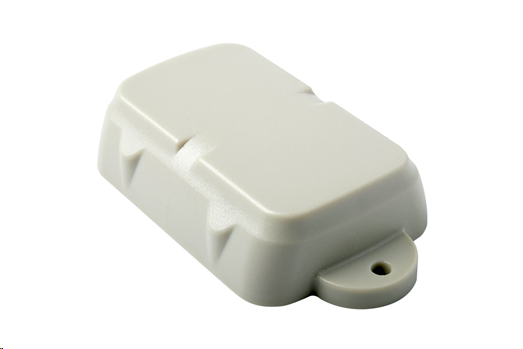
This getting started guide is only for the cellular version. The Oyster is also available with other low power communication technologies, such as LoRaWan, Sigfox, and NB-IoT.
Compliance
Red Simplified DOC
The 2G and 3G EU version of the product are RED certified. Digital Matter declares that the radio equipment type Oyster 2G and Oyster 3GE are in compliance with Directive 2014/53/EU.
The full text of the EU Declaration of conformity is available here.
FCC
The 3G North America version of the product is FCC and PTCRB certified (May 2017)
The OYSTER-3GN3G contains transmitter module:
- FCC ID: R17EU910N3
- IC ID: 5131A-UE910N3
In the Box
You'll get a compact box containing the Oyster. The 6 housing screws will be in a small packet inside the housing.
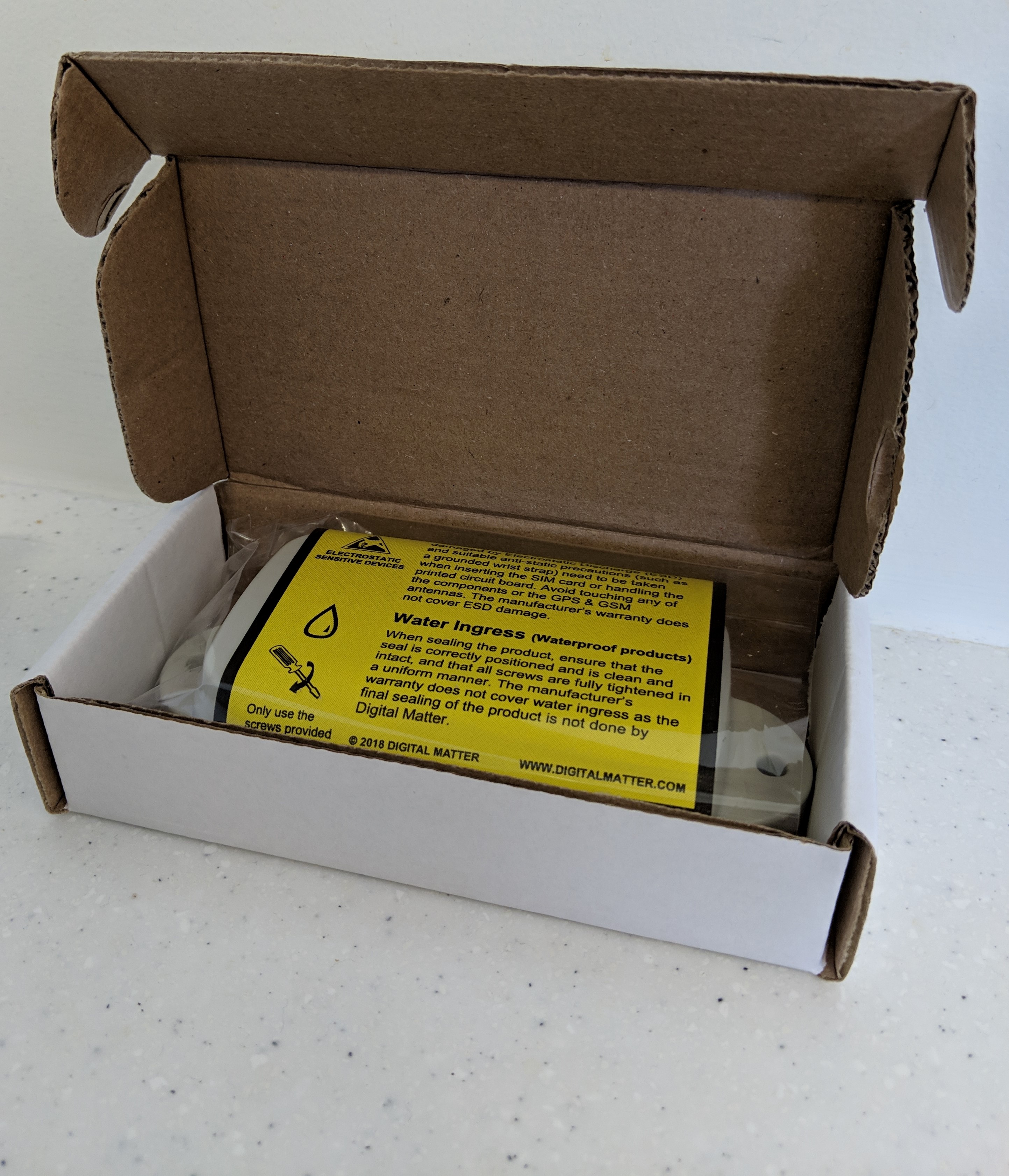
Setting It Up
SIM Card
The Oyster uses a Micro SIM card, form factor 3FF. The SIM holder is on the underside of the PCB. The device will need to be lifted out of the housing to insert the SIM. When handling the Oyster be careful not to touch the GPS antenna, to minimise the risk of damaging the sensitive GPS amplifiers with static discharge.
Slide the SIM into the holder with the keyed corner first and the SIM contacts orientated down to the main board.
To easily get up and running:
- The SIM should not have a PIN on it, unless you use the device specific PIN.
- The SIM should have credit or airtime
- The SIM should use one of the APN's built into the firmware – this is the AutoAPN feature.
If the APN is not included in AutoAPN, set it by SMS. Click here for more information on Auto-APNs.
Batteries
Note: It is very important to use 1/5V Lithium AA batteries. If you use normal Alkaline AA Batteries then the batteries will only operate for about 50% of their useful life.
Danger
The Oyster does not support higher voltage 3.6V Lithium Thinyl Chloride batteries - do not use these as they will damage the regulator in the Oyster!
The Oyster uses 3x 1.5V Lithium batteries and does not have reverse voltage protection to ensure longer battery life. Industrial 1.5V Lithium AA batteries are also available at bulk pricing. The Lithium batteries have excellent performance and capacity, and allow the Oyster Cellular to be used in extreme temperatures and climatic conditions that other tracking devices simply cannot operate in.
Be sure to insert the batteries with the correct polarity, negative being springs.
Once inserted, the LED should flash continuously, if it does not it means the unit has not yet reset. In this case, remove the batteries for a minute to allow an residual charge to drain and reinsert. Failure to reset the unit will prevent automatic APN detectin and proper resetting of the battery life statistics.
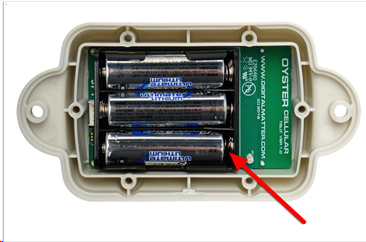 |
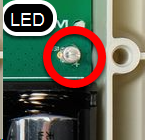 |
The Housing
You must take care to seal the device carefully to achieve the IP-67 rating (dust ingress and moisture protection).
Ensure that the clear silicon seal is in good condition, is lying flat, and is not fouled by any plastic debris or other material.
Close the housing, and gently squeeze it shut. Foam on the lid will compress against the batteries, holding them firmly in place.
Tighten the 6 screws to a uniform tightness. On the first assembly, the screws may be quite stiff. An electric screwdriver with a torque limiting clutch is recommended. The torque setting should be 0.7 Nm.
For reference: the screws used are a thermoplastic screw: 3.5mm x 12mm (BN82428).
If you wish to replace the batteries and open the housing, be sure to check that the silicon seal is in good condition before closing the housing again
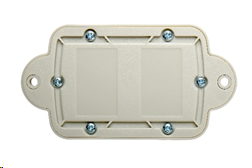
Getting Online
Once the batteries are inserted, the internal LED will come on and flash. The device will do the following:
- Connect to the server: If the SIM card works, the device will connect to the OEM Server.
- It will attempt to download any firmware and parameter updates.
- It will fetch fresh GPS aiding data.
- Get a GPS Fix: the device will attempt to get a GPS fix. Speed this up by moving to an area with good GPS signal.
- Reconnect to the server: The device will attempt to connect again to upload the result of the GPS Fix.
If the device does not complete these steps in 10 minutes, it will go to sleep and try again on the next heartbeat or the next trip start.
Go to www.oemserver.com/installer and search for the serial number. Confirm that it has connected recently. If the LED flashes but the Oyster does not connect, check the SIM is in the holder correctly and check that the SIM is working.
APN Setup
If the APN for the SIM is not in the AutoAPN list, it must be set by SMS. To do this:
Send an SMS from any phone to the cellphone number (MSISDN) of the SIM card.
Use the following format for the APN text message:
#*,APN,<apn_name>,<username>,<password>If the <username> and <password> are blank or not required then you can leave them off.
You can also reset a device to use auto-APN by sending a blank APN:
#*,APNExample with username and password:
#*,APN,myAPN,joebloggs,secret123Example without username and password:
#*,APN,myAPNDevice Installation
The Oyster can be mounted on the asset to be tracked using screws, bolts, cable ties, or industrial adhesives. When choosing a mounting point, you have two competing goals:
To minimise the chances of the device being accidentally crushed or dislodged.
To maximise the GPS and mobile reception and provide adequate ventilation.
Since the Oyster is a battery powered device, reception is critical to its performance. While other members of the DM product family rely on their high-quality GPS receivers for enhanced accuracy and the ability to operate in very low signal, the primary concern for the Oyster is the battery used during each GPS fix.
If possible, choose a mounting point that will not result in elevated temperatures. For instance, mounting the Oyster in direct sunlight on the dash of an unventilated cabin may cook the batteries, leading to abnormally short service life.
Default Settings
By default, the Oyster is setup for trip tracking. The following default settings apply:
| Out of Trip: | 12 hour heartbeats. This is a GPS point and an upload every 12 hours. |
| In Trip: | Start trip threshold of 250m |
| Upload on trip start & end. | Yes |
| In Trip Logging Period | 120 seconds |
| In Trip Upload | 30 minutes/1800 seconds |
| Trip End | 5 minutes of no movement detected |
These settings and many more are configurable in the OEM Admin Interface. The defaults provide a good starting point. It is important to monitor and tweak your settings to ensure the battery life is acceptable. Incorrect settings can flatten the batteries quickly. Contact Support for help with this.
